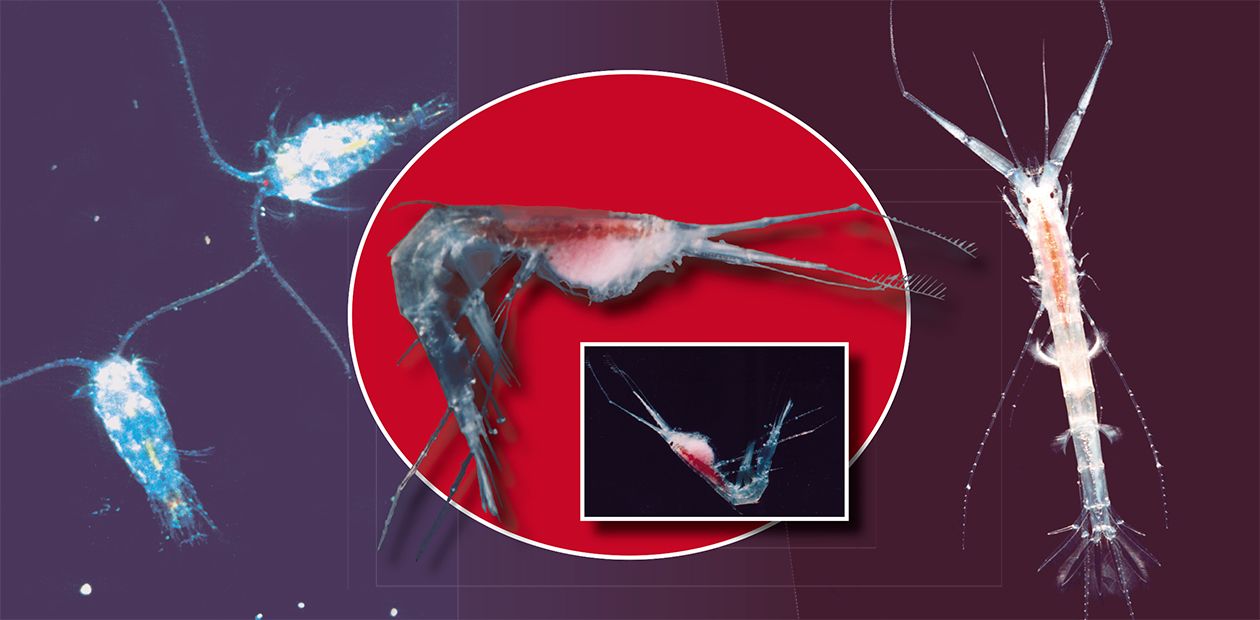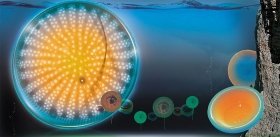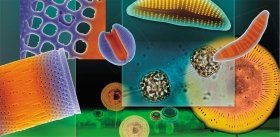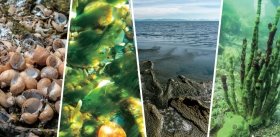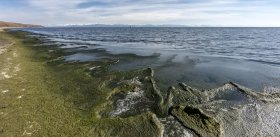The Diversity of Crustacea in Baikal
Baikal depths resemble much the ocean depths. Animals having striking looks and habits inhabit the lake. Some of them, such as endemic semitransparent viviparous fish golomyanka (genus Comephorus) and small crayfish epishura (Epischura baicalensis), the dominating species of Baikal zooplankton, are often mentioned in popular literature. Unfortunately, another endemic Crustacea, macrohectopus (M. branickii), the only large-size representative of the lake zooplankton, is mentioned undeservedly seldom.
‘Sensitive predator’
Macrohectopus belongs to the order of Amphipoda that counts more than 300 species in Baikal. However, only macrohectopus that lives at the depth of more than 1000 meters is the pelagic species. Other Baikal amphipoda are representatives of the benthos, they share the territory of the bottom and near-bottom waters.
Who was the immediate ancestor of macrohectopus? When did this species occupy the niche? Why does the crustaceans prefer to live in the dark and cold bottom layers of the lake, though every night they have to go up to the surface to get algae and small invertebrates? Disputes on these subjects are never ending. The answers to the questions can be found only in the past, because macrohectopus, following the estimates of molecular taxonomists, is not a young species in terms of Baikal timescale.
The study of the biology of the species is complicated by the fact that the standard fishing gear, even large ocean plankton nets with the opening diameter of 80 cm, undercatches the crustaceans because they are very agile. An additional difficulty is that the animals gather in aggregates. Thus, remote methods should be used to count their number.
Young individuals (with the body length of 1–3 mm), young females (3–14 mm), mature females (14–40 mm), and males (3–6 mm, much shorter than females!) aggregate during the day in different and narrow layers of the water column. Detailed hydroacoustic recording using high-frequency echo sounders revealed that there are aggregates of macrohectopus in different places of the lake hollow. However, it is still unclear whether all inhabitants zof the giant ‘dwelling’ are representatives of the same giant population or there are several populations. Some scientists believe that there are even different species of macrohectopus in the lake. This problem is to be solved by molecular biologists. In studying the genetic diversity of the small golomyanka, for example, they established that this Baikal species does not split into separate populations. Another problem waiting for a solution is concerned with the mechanisms that provide successful mixing of the inhabitants of the Baikal water depth at great distances (from the north to the south the lake stretches for more than 600 km). So far no proper active horizontal migrations have been found either for macrohectopus, or for golomyankas…
***
One more unclarified question that has practical significance is concerned with the number of macrohectopus individuals. The study of pelagic and bottom fish showed that macrohectopus is the main food resource for many species, even the seal likes it. But, according to the estimates, to feed the fish, the number of crustaceans in the lake should be greater than the available conventional estimate. Only a very detailed hydroacoustic monitoring of the whole lake can provide an answer to the question.
In the last decade thanks to the application of new research methods the veil of mystery has been lifted from some Baikal animals.
Biologists are amazed by the distinct adaptive response reflected in the appearance of macrohectopus. These crustaceans are strong and active swimmers. Experimental observations confirmed their good maneuverability. Echo sounding from the board of the research vessel Vereschagin made it possible to determine that the aggregations of macrohectopus can reach the velocity of up to 4 m/min in vertical migrations, which is impressive considering that the maximum size of the animals is 40 mm.
Look at the portrait of the crustacean macrohectopus with bristled antennae that brings an idea of a bird if birds could live underwater!
The comprehensive studies of daily migrations of the pelagic animals performed by a team of young limnologists in 1999-2001 confirmed that the nutrition and migration behavior of macrohectopus was close to that of fish, whereas the young individuals of golomyanka (8–10 mm in size) were close to zooplankton. Despite the small size, macrohectopus is rather offensive: the full-face representation of macrohectopus reminds of the main character from the Predator movie. There is evidence that macrohectopus can even attack the young golomyanka. Macrohectopus eats even its own posterity.
During the day macrohectopus hides at the depths of the lake, and at night goes hunting to the surface water layers. This life-style made the crepuscular predator very sensitive to light. If at night the ship searchlight is on, the crustaceans do not come to the surface and stay at depths of over 40 m making a dense cluster there. The illuminance of water at this depth and such conditions is only 0.0001 lk. Extremely high light-sensitivity suggests the dependence of macrohectopus migrations on the phases of the moon; a similar phenomenon related to the restricted vertical migrations was found in Baltic mysids (Mysis mixta), an ecological equivalent of macrohectopus.
***
The use of electron microscopes made it possible to reveal unique components of the macrohectopus’s eyes that ensure the high light sensitivity. Furthermore, the pigment cells shielding the light were found to be rudimentary, which makes the eyes unprotected from excess light. Sometimes the crustaceans are found by day on the water surface. Whether this is normal or not – is not an easy question! Most probably the crustaceans occasionally get in these layers together with the plankton organisms that sometimes cannot resist the motion of water, lose their bearings and probably grow blind.
Echo sounders revealed another important feature in the behavior of macrohectopus which provides invaluable information on the structure of the Baikal ecosystem. The point is that the species is stenobiontic, i.e. is tightly bound to Lake Baikal’s ‘core’, and is not characteristic of the littoral zone. As to the niche of the biotope, the echo sounding of the water column in the Barguzin Bay and Maloye More demonstrated that the depth close to 100 m limits the aggregations of the crustaceans. Only few individuals are met in shallower places. Actually, these findings supported the phenomenon known in hydrobiology as ‘avoidance of the littoral zone’. Underwater filming showed that the crustaceans are met in shallow-water zones, but only if the bottom below is ‘naked’, without bottom plants.
This suggests that the belts of Baikal bottom algae that occur at the depths of not more than 100 m (the same depths in the water column delimit the photosynthesis zone) is an indication of ‘foreign territory’ for macrohectopus. The Amphipodae live among bottom plants in various microbiotypes. The line of demarcation dividing the animals that belong to benthic or pelagic food webs also lies at a depth of about 100 m.
Which receptors does macrohectopus use to detect the ‘foreign territory’? Photoreceptors? But they observe the border during the night as well. Do they have chemical or mechanical receptors? Indeed, sensory organs were discovered in the crustaceans but their function has not been identified. The echogram shows that crustaceans ‘run away’ if the sound in water increases abruptly, for example, from the turn of a vessel. Maybe the littoral zone is noisier than the open deep-water Baikal? There should be threshold values that macrohectopus unambiguously perceives as «No thoroughfare!» sign.
***
Once we observed the migration and nourishment of epishura and young golomyanka in winter. The observations coincided with the frontal passage (extremely strong wind). Our young colleagues did not stop the observations and continued to take samples every three hours. They noticed that the fish and crustaceans abruptly reduced the feeding activity during the stormy night and changed the character of movement. Two explanations of the changes were advanced: electromagnetic field anomalies and infrasound wave leading the gale-strength wind. According to the literature, as a rule, fish without scales are electrosensitive; one example is golomyanka. Unfortunately, the issue of magneto- and electrosensitivity of Baikal animals is still a ‘blank spot’.
The photic zone (the depth of the water that is exposed to sufficient sunlight) in Baikal ends at the depths of about 500 m. What signals do golomyanka and macrohectopus receive? What motives make them repeat day-to-day vertical migrations? Is it the hunger only? Or are they supersensitive to light? These questions can be solved only using the remote acoustic, holographic, and observational methods of studying the behavior of the animals in the natural conditions. Biological studies should be combined with the detailed investigation of the habitat, chemical and sound signals, electromagnetic fields, etc.
It would be very helpful to learn why and how the Baikal endemics could coexist and survive for millions of years. Humankind should use this knowledge to preserve its own habitat.
‘Fastidious Consumer’
Free-living copepods (Copepoda) can be found almost in any freshwater reservoir. They live under the ice of Antarctic lakes, in Nepal mountain lakes, and even in a volcanic lake at the altitude of 5930 m! These ubiquitous and often very numerous crayfish play a key role in water ecosystems, being the key components of food chains.
Baikal is not an exception. In total, there are more than 2000 species of freshwater crustaceans worldwide; more than a hundred of species and subspecies live only in Lake Baikal. At but one draught of the plankton net in Baikal waters, one can catch representatives of almost 20 species. Among them, only 10 species can be considered as true pelagic (living in the water column throughout their life). The others are caught by accident, on their way from the bottom habitats or shallow water algal thickets.
The most widely known among Baikal copepods is epishura (Epischura baicalensis). Along with the well-known Baikal omul this endemic has become a kind of Baikal symbol, especially as far as the ecological condition of Baikal waters is considered. The point is that epishura is almost the main element of Baikal ecosystem that is responsible for water cleanliness. Is it true? To answer this question, we should familiarize ourselves with the lifestyle and habits of our ‘hero’.
***
Though Baikal epishura is an ancient relic species, it can serve as a modern example of very successful settling of the water column from the water surface to the largest depths, avoiding only warmed-up shallow parts of the lake. As to the exterior, the copepod has long graceful antennae, and a crystal transparent proportional body decorated with bright yellow-orange inclusions (fat drops). From a bathyscaphe or in video records the movements of the copepods are seen as a suspension of ‘came alive’, ridiculously jumping grains of semolina.
Innumerable representatives of this crustacean dominate in biomass over other species of Baikal zooplankton throughout the year. Epishura is favorite forage for all species of pelagic fish, actually for young fish of any kind living in the coastal zone of the lake. It is a ‘tidbit’ for predatory zooplankton representatives – large rotifer, cyclop and macrohectopus.
Epishura eats seaweed and, to a lesser degree, bacteria. It is a kind of a small water ‘cow’ pasturing at phytoplankton meadows. The studies on biota circulation in the pelagial zone showed that epishura withdraws up to onet-third of the primary production of seaweeds, main producers of organic substance. This fact combined with the countless numbers of crustaceans stipulates the prevailing opinion on the key role of epishura in cleaning lake waters.
Based on the way of feeding, Epishura is classed among filtering organisms. Its favorite food is diatom algae widely spread in Baikal. According to the distance between the filaments on its filtering oral region, the minimal sizes of particles which it can catch is 0.5-2.5 microns (Afanasieva, 1989). Using the epifluorescence microscope, it was proved that this surprising species is capable of consuming the Baikal little ones - picocyanobacteria (Naumova et al., 2001). This discovery confirmed the role of epishura as the main ‘cleaner’ of the lake.
***
However, epishura is characterized by another interesting feature, which is often ignored. Being fastidious, not to say squeamish, epishura does not filter automatically everything that falls into the ‘filtering sieve’!
It is believed that herbivorous copepods decide ‘to eat or not to eat’ only after ‘testing’ every particle with the help of mechanical and chemical receptors. Inedible particles are rejected. Thus, they use the filtering device to catch particles, rather than simply for passive sifting; therefore the spectrum of consumed particles is determined not only by the size of filtering mesh (Lampert, Sommer, 1997). It should be noted that epishura practically does not consume detritus and is very selective in eating diatoms and other algae. In experiments, epishura selected certain species of picocyanobacteria from those offered.
Thus, when speaking about cleaning Baikal waters of numerous particles of different nature, it would be fair to recall a number of other Baikal inhabitants, not so legible and well-known: first of all — protozoans (flagellates and infusorians), rotifers, other crayfish; eventually — bacteria decomposing the detritus. But this is another story altogether…


